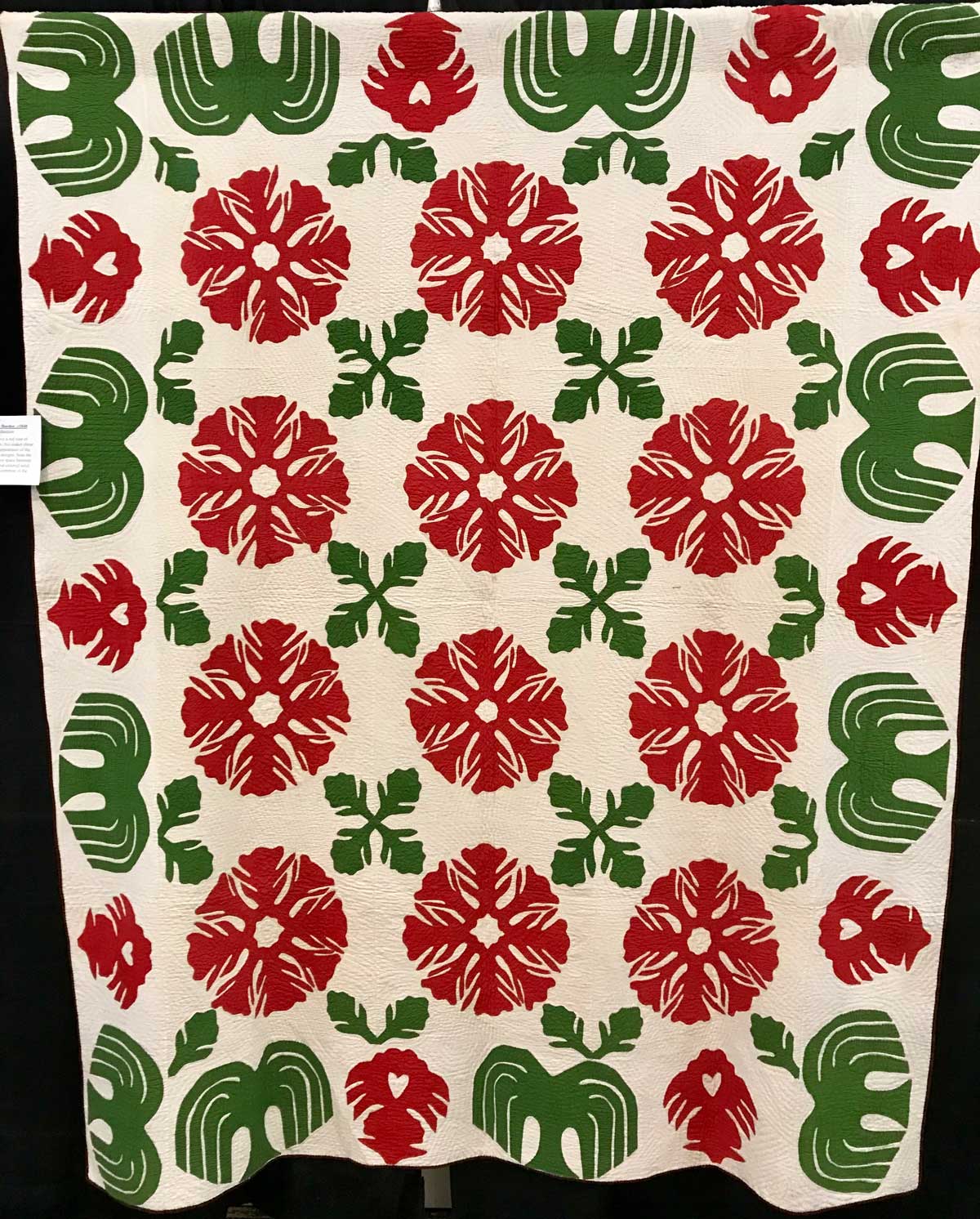Fall in love with New York – AQSG adventures, Part 3
February 2025
Covering Quilts
Fall in love with New York – AQSG adventures, Part 3
by Sandra Starley
Every fall, quilt historians and people who just love old and new quilts attend the annual meeting of the American Quilt Study Group (AQSG). So much happens during the multi-day event that it is taking three columns to share a bit of the amazing 2024 Seminar in Tarrytown, NY. The first columns focused on the wonderful tours to historical sites covering the Tri-State area (New York, New Jersey, and Connecticut). I also high-lighted the stellar New York quilts exhibit and the bed turnings, both of which showcased the unique quilt styles of the Empire State.
The second column focused on the scholarly paper presentations which can be accessed in Uncoverings through AQSG along with the other interesting speakers and entertainment, including the live auction with Dancing Juliettes and the Headless Horseman. We were in Sleepy Hollow, after all. Please see the prior columns to learn more (November 2024 and December 2024).
Just a glimpse of how magical those several days were in the Hudson River Valley, but there was so much more … myriad study cen-ters, a silent auction, show and tell, book signings, and the vendors mall.
Observe, share, and learn: study centers
First, a brief explanation of what a study center entails. It is a two-hour interactive discussion of a specialized topic. It involves a Power-point presentation as well as actual quilts or fabrics shared by the presenter and also brought in by attendees. These sessions are smaller and allow for more dialogue between participants and study center leaders; 2024 Study Centers numbered more than a dozen and covered a very wide range of topics and several centuries from a 1785 fabric honoring General George Washington to the “Art of Make Do Quilting” (using vintage fabrics and blocks to make modern quilts) and every-thing in between, including that ubiquitous little icon – Sunbonnet Sue and the inspiring Bertha Meckstroth and trail-blazing Jean Ray Laury.
Antique quilt and fabric acquisition opportunities abound
Most of the seminar attendees are at least casual collectors of antique textiles, while many are avid col-lectors and they all can find one must-have item to bring home from the many avail-able options. The vendors’ mall is comprised of some of the most esteemed national quilt dealers, smaller sellers, and those new to antique sales. It is like going to the best quilt museum and being able to get up close and touch the art and even buy a piece that captures your heart. It is an amazing experience every year! Likewise, the silent auction room is jam-packed with beautiful quilts, quilt tops, blocks, fabrics, etc., donated by members and available to bid on and buy.
There are always many treasures to be found there.
Additionally, the endowment table features a delightful mix of antique and reproduction fabrics and other tidbits to purchase and support the long-term funding of AQSG. The annual show-and-tell event give members the opportunity to show off unique items often purchased at prior or the current seminar and/or looking for new homes. And finally, book sale and signing offers members the chance to purchase books authored by fellow members to increase their knowledge of prior acquisitions or to encourage new collections.
I hope this inspires you to join the American Quilt Study Group and come to Portland, ME, for Seminar 2025. Also, visit their website to attend the virtual Winter Seminar Jan. 30 – Feb. 2, 2025.

Circular Papercut with Willow Tree Border, circa 1840, New York 71” x 85”, Sharon Waddell Collection (Seminar Exhibit). (Image courtesy of the author)
Sandra Starley is nationally certified quilt appraiser, quilt historian, and avid antique quilt collector. She travels throughout the U.S. presenting talks on antique quilt history, fabric dating classes and trunk shows as well as quilting classes. Learn more at utahquiltappraiser.blogspot.com. Send your comments and quilt questions to SandraStarley@outlook.com
Want a break from quilting? Try a new bag (Bag making 101)
June 2024Covering Quilts Want a break from quilting? Try a new bag (Bag making 101)by Sandra Starley Quilted bags, totes, and fabric pouches of all sizes are having a moment. Why not join in on the fun? As I have mentioned several times, giving yourself a...
The Churn Dash or Monkey Wrench pattern, Part II
May 2024Covering Quilts Make it modern: The Churn Dash or Monkey Wrench pattern, Part IIby Sandra Starley As I mentioned last month, if you have not been making butter or repairing wagons, you may not be aware of the history behind the classic Churn Dash or...
Quilt history revisited: The Churn Dash or Monkey Wrench pattern
April 2024Covering Quilts Quilt history revisited: The Churn Dash or Monkey Wrench patternby Sandra Starley Have you been churning butter or fixing wagons recently? If not, you might appreciate a bit of background information on the origins of the two most...
Ocean Waves quilts revisited
March 2024Covering Quilts Ocean Waves quilts revisitedby Sandra Starley Nature has long inspired quilters. As American quilting developed in Eastern seaboard settlements, it is not surprising that early quilt designs and pattern names often carried a nautical...
Journeys in quilt history: Political patchwork edition
February 2024Covering Quilts Journeys in quilt history: Political patchwork editionby Sandra Starley Learning about the past can be fun! One of the things that I love most about collecting antique quilts, blocks, and fabrics are all the interesting tidbits of history...
My Old Kentucky Home – Quilt adventures with the American Quilt Study Group
December 2023Covering Quilts My Old Kentucky Home – Quilt adventures with the American Quilt Study Groupby Sandra Starley I recently revisited “My Old Kentucky Home,” having lived there briefly as a youngster, for the Annual Seminar of the American Quilt Study...

